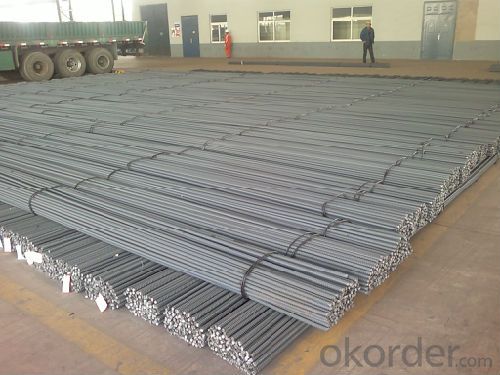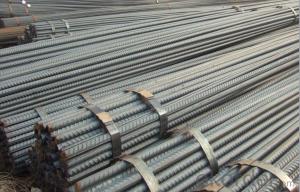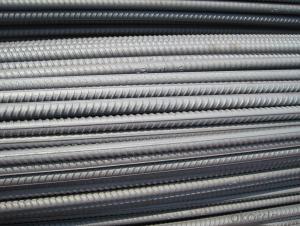GB Standard HRB400 Steel Deformed Bar 28mm/32mm
- Loading Port:
- Tianjin
- Payment Terms:
- TT or LC
- Min Order Qty:
- 50 m.t
- Supply Capability:
- 20000 m.t/month
OKorder Service Pledge
OKorder Financial Service
You Might Also Like
GB Standard HRB400 Steel Deformed Bar 28mm/32mm
Description:
-Standard: GB
-Material: HRB400
-Specification:
| Diameter(mm) | Section Area(mm2) | Mass(Kg/m) | Length(m) |
| 28 | 615.8 | 4.83 | 9, 12 or as customs' request |
| 32 | 804.2 | 6.31 | 9, 12 or as customs' request |
Chemical Composition(%) of GB Standard HRB400 Steel Deformed Bar 28mm/32mm:
| C | Mn | Si | S | P | V |
| ≤0.25 | ≤1.60 | ≤0.08 | ≤0.045 | ≤0.045 | 0.04-0.12 |
Mechanical Properties of GB Standard HRB400 Steel Deformed Bar 28mm/32mm:
Yield Strength (N/cm²) | Tensile Strength (N/cm²) | Elongation (%) |
≥400 | ≥570 | ≥14 |
Usage and Applications of GB Standard HRB400 Steel Deformed Bar 28mm/32mm:
Deformed bar is widely used in buildings, bridges, roads and other engineering construction. Big to highways, railways, bridges, culverts, tunnels, public facilities such as flood control, dam, small to housing construction, beam, column, wall and the foundation of the plate, deformed bar is an integral structure material. With the development of world economy and the vigorous development of infrastructure construction, real estate, the demand for deformed bar will be larger and larger.
Packaging & Delivery of GB Standard HRB400 Steel Deformed Bar 28mm/32mm:
Packaging Detail: products are packed in bundle and then shipped by container or bulk vessel, deformed bar is usually naked strapping delivery, when storing, please pay attention to moisture proof. The performance of rust will produce adverse effect.
Each bundle weight: 2-3MT, or as required
Payment term: TT or L/C
Delivery Detail: within 45 days after received advanced payment or LC.
Label: to be specified by customer, generally, each bundle has 1-2 labels
Trade terms: FOB, CFR, CIF
Images of GB Standard HRB400 Steel Deformed Bar 28mm/32mm:


*If you would like to get our price, please inform us the size, standard/material and quantity. Thank you very much for your attention.
- Q:How are steel rebars protected from fire damage?
- Steel rebars are protected from fire damage through various methods. One commonly used method is the application of fire-resistant coatings. These coatings are specifically designed to withstand high temperatures and prevent the steel from reaching its critical temperature, which is when it starts to lose its structural integrity. Another method is the use of fire-resistant concrete encasement. In this method, the rebars are embedded within a layer of concrete that has been specifically designed to resist fire. This concrete acts as a barrier, preventing the heat from directly reaching the steel rebars and thus protecting them from fire damage. Additionally, fire-resistant wraps or blankets can be used to provide temporary protection to steel rebars during construction. These wraps are made from fire-resistant materials and are applied directly to the rebars, creating a barrier that prevents direct exposure to fire. It is important to note that the level of fire protection required for steel rebars depends on the specific building codes and regulations in place. These codes typically specify the minimum fire resistance rating that must be achieved for structural elements, including rebars, in order to ensure the safety of the building and its occupants.
- Q:What is the typical weight of a steel rebar?
- The typical weight of a steel rebar can vary depending on its diameter and length. However, the most commonly used steel rebar in construction projects is typically 20 feet long and ranges in diameter from 1/2 inch to 1 inch. For this standard size, the weight can range from around 7.5 pounds to 24 pounds per linear foot. Therefore, a 20-foot steel rebar can weigh anywhere between approximately 150 pounds to 480 pounds. It is important to note that different countries may have different weight standards for steel rebars, so it is always advisable to consult local specifications and standards for accurate information.
- Q:Can steel rebars be used in the construction of museums and art galleries?
- Yes, steel rebars can be used in the construction of museums and art galleries. Steel rebars provide structural reinforcement and can help ensure the stability and longevity of the building. They are commonly used in the construction industry to reinforce concrete and enhance the overall strength of structures.
- Q:What is the cost of steel rebars?
- The cost of steel rebars can vary depending on various factors such as the grade of steel, market conditions, and location. On average, the cost of steel rebars ranges from $500 to $800 per metric ton. However, it is important to note that prices can fluctuate due to factors like supply and demand, raw material costs, and any additional taxes or tariffs imposed on steel imports. It is recommended to contact local suppliers or check market reports for the most up-to-date and accurate pricing information.
- Q:Are there any specific safety measures to be taken while working with steel rebars?
- Yes, there are specific safety measures that should be followed when working with steel rebars. These include wearing appropriate personal protective equipment (PPE) such as gloves, safety glasses, and steel-toed boots to protect against cuts, punctures, and falling objects. It is important to handle rebars with care to avoid injuries, use proper lifting techniques, and ensure they are securely stored to prevent accidents. Additionally, workers should be trained on safe work practices and be aware of potential hazards such as tripping, impalement, and exposure to hazardous substances during cutting or welding processes. Regular inspections of equipment and work areas are also essential to maintain a safe working environment.
- Q:How do steel rebars affect the overall aesthetics of a structure?
- Steel rebars do not typically have a significant impact on the overall aesthetics of a structure, as they are typically hidden within the concrete. However, the proper placement and alignment of rebars can contribute to the structural integrity of the building, which indirectly affects its overall visual appeal.
- Q:What are the guidelines for inspecting and testing steel rebars on-site?
- Inspecting and testing steel rebars on-site is crucial to ensure the structural integrity and safety of a construction project. Here are some guidelines to follow: 1. Visual Inspection: Start by visually inspecting the rebars for any visible defects, such as rust, cracks, or deformities. Pay attention to the rebars' size, shape, and alignment, as they should comply with the project's specifications and standards. 2. Documentation: Maintain accurate documentation of the rebars, including their origin, grade, and dimensions. This information will help track the rebars' compliance with the project's requirements and identify any potential issues. 3. Sampling: Take representative samples from each batch of rebars for further testing. The number of samples required may vary depending on the project's specifications and regulatory requirements. 4. Dimensional check: Measure the length, diameter, and shape of the rebars to verify compliance with the project's requirements. Ensure that the rebars are not bent or twisted beyond the permissible limits. 5. Chemical Composition Analysis: Conduct chemical composition analysis to verify that the rebars meet the specified standards. This analysis typically includes testing for elements like carbon, sulfur, phosphorus, and manganese. 6. Tensile and Yield Strength Testing: Perform tensile and yield strength tests on the rebars to determine their mechanical properties. This testing helps ensure that the rebars can withstand the expected loads and stresses during construction. 7. Bend Test: Conduct a bend test to assess the rebars' ductility and ability to withstand bending without fracture or significant deformation. This test is particularly important for rebars used in reinforced concrete structures. 8. Ultrasonic Testing: Use ultrasonic testing techniques to detect any internal defects, such as voids, cracks, or inclusions, that may affect the rebars' performance. This non-destructive testing method helps identify potential weaknesses that are not visible to the naked eye. 9. Corrosion Resistance Assessment: Evaluate the rebars' resistance to corrosion, especially in environments prone to moisture or chemical exposure. This assessment could involve various techniques, such as corrosion potential measurement or chloride content analysis. 10. Documentation and Reporting: Maintain comprehensive records of all inspection and testing activities, including the test results and any deviations from the project's specifications. This documentation serves as evidence of compliance and assists in future audits or quality control checks. It is worth noting that these guidelines serve as a general framework for inspecting and testing steel rebars on-site. Always refer to project-specific requirements, industry standards, and local regulations for a more detailed and accurate inspection and testing procedure.
- Q:Why is the difference between left and right threads? What's the difference?
- The design direction of rotation screw steel, steel and related crystal. Due to crystal dislocation, under the tensile stresses along a surface slip between the crystal, for single crystal, slip surface and tensile stress direction angle of about 45, at the same time, the crystal will around the stress-induced rotation axis. According to the characteristics of steel, the surface of the reinforcement design into a spiral shape, can effectively improve the strength of steel, save materials, reduce the weight of the building. Of course, there are combined with concrete between considerations.
- Q:What is the process of threading steel rebars?
- Threading steel rebars involves creating threads on the ends of the rebars to allow for easy and secure connection with other rebars or structural elements. This is typically done using a machine called a rebar threading machine. The first step is to cut the rebars to the desired length and clean the ends to remove any dirt, rust, or debris that could interfere with the threading process. This ensures a smooth and accurate threading operation. Once the rebars are prepared, the rebar threading machine is set up. It consists of a spindle that rotates at a high speed, along with a threading die positioned on the spindle. The threading die has grooves and ridges designed to cut threads into the rebars. To thread a rebar, one end is inserted into the threading machine while the other end is held firmly in place. The machine is then started, and the spindle rotates to cut into the rebar's surface, creating threads by removing small amounts of material. The machine is operated until the desired length of threads is achieved, which can vary depending on project requirements and the type of connection being made. It is crucial to ensure accurate and consistent cutting of the threads to maintain the structural integrity of the rebar connections. After the threading process is complete, the threaded rebars are inspected to ensure clean and defect-free threads that meet the required standards. They are then ready for use in construction projects, where they can be connected to other rebars or structural elements using various methods such as couplers or nuts. In conclusion, threading steel rebars involves cutting and cleaning the rebars, setting up a rebar threading machine, inserting the rebars, and using a threading die to create threads. This process ensures easy and secure connection of rebars in construction projects, providing strength and stability to the structures they are used in.
- Q:What are the different types of steel rebars used in foundation construction?
- Foundation construction commonly utilizes various types of steel rebars. These include: 1. Mild Steel Rebars, also known as black bars, are the most frequently employed in foundation construction. They possess a low carbon content and are easy to handle. Mild steel rebars offer satisfactory tensile strength and are cost-effective. 2. High Yield Strength Rebars possess a higher carbon content and undergo heat treatment to enhance their strength. They are commonly applied in areas requiring additional strength, such as high-rise buildings or seismic zones. High yield strength rebars exhibit superior resistance against tensile and compressive forces. 3. Epoxy-Coated Rebars are coated with epoxy resin to safeguard them against corrosion. They are often utilized in areas where the foundation is exposed to moisture or chemicals, such as marine or industrial environments. The epoxy coating acts as a barrier, preventing water and other corrosive substances from reaching the steel and causing rust. 4. Galvanized Rebars are coated with a layer of zinc to shield them from corrosion. The zinc coating provides excellent resistance against moisture and chemicals, making galvanized rebars suitable for use in high humidity areas or in concrete containing chloride ions. They are frequently employed in coastal regions or structures like bridges and parking garages. 5. Stainless Steel Rebars possess high corrosion resistance and are implemented in environments where other types of rebars may fail due to corrosion. They are commonly utilized in structures exposed to aggressive environments, such as chemical plants or wastewater treatment facilities. Stainless steel rebars are also employed in regions with a high risk of corrosion, such as coastal or humid areas. In conclusion, the selection of steel rebars for foundation construction depends on factors such as project requirements, environmental conditions, and the desired level of corrosion resistance. It is crucial to choose the appropriate type of rebar to ensure the durability and strength of the foundation.
1. Manufacturer Overview |
|
|---|---|
| Location | |
| Year Established | |
| Annual Output Value | |
| Main Markets | |
| Company Certifications | |
2. Manufacturer Certificates |
|
|---|---|
| a) Certification Name | |
| Range | |
| Reference | |
| Validity Period | |
3. Manufacturer Capability |
|
|---|---|
| a)Trade Capacity | |
| Nearest Port | |
| Export Percentage | |
| No.of Employees in Trade Department | |
| Language Spoken: | |
| b)Factory Information | |
| Factory Size: | |
| No. of Production Lines | |
| Contract Manufacturing | |
| Product Price Range | |
Send your message to us
GB Standard HRB400 Steel Deformed Bar 28mm/32mm
- Loading Port:
- Tianjin
- Payment Terms:
- TT or LC
- Min Order Qty:
- 50 m.t
- Supply Capability:
- 20000 m.t/month
OKorder Service Pledge
OKorder Financial Service
Similar products
New products
Hot products
Hot Searches
Related keywords





























